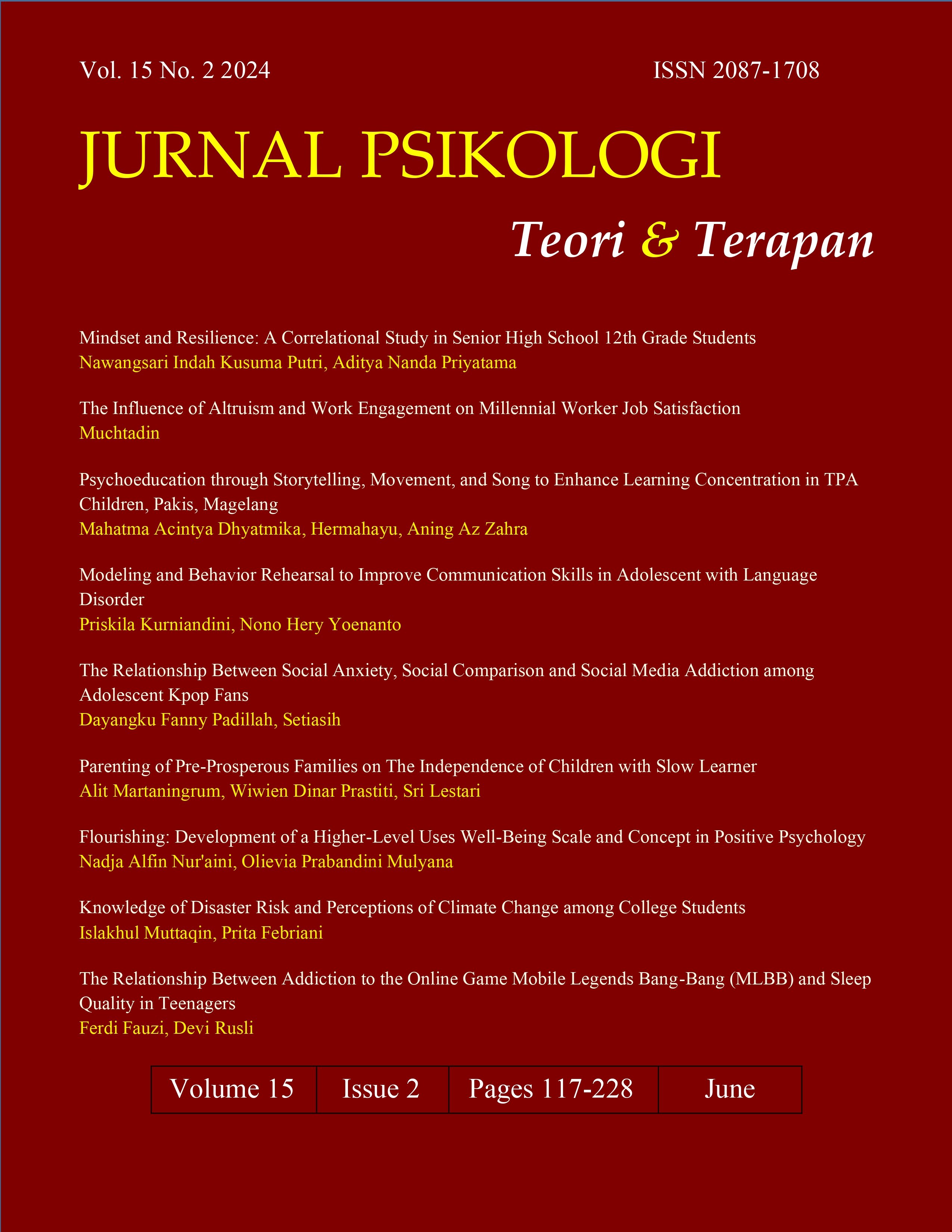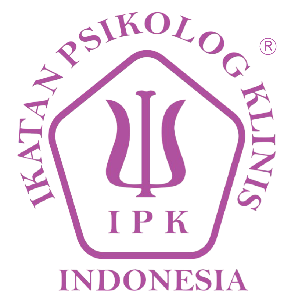Modeling and Behavior Rehearsal to Improve Communication Skills in Adolescent with Language Disorder
DOI:
https://doi.org/10.26740/jptt.v15n02.p152-163Keywords:
Modeling, behavior rehearsal, communication skill, language disorder, pemodelan, latihan perilaku, kemampuan berkomunikasi, gangguan bahasaAbstract
Background: Adolescents with language disorder have significant language difficulties in many situations and impact their communication skills. Communication difficulties experienced by adolescents with language disorders can increase the risk of feeling anxious in social situations and having fewer peer relations. Therefore, interventions are needed that can optimize communication skills. Objective: The aim of this research is to find out whether modeling and behavior rehearsal can improve communication skills in adolescent with language disorder. Method: This research is a quantitative research that uses single subject ABA design. The participant is a 14-year-old girl with language disorder. There are 4 skills that are taught & observed, such as giving comments, asking relevant questions, asking the other person's opinion, and paying attention to the other person's attitude while speaking. Results: All communication skills is increasing, including ask the other person's opinion and provide comments that match with the topic. Conclusion: This proves that modeling and behavior rehearsal are effective in improving adolescent's communication skills with language disorder.
Abstrak
Latar Belakang: Remaja dengan language disorder memiliki hambatan yang signifikan dalam berbahasa di berbagai situasi dan itu berdampak pada kemampuan komunikasi. Kesulitan berkomunikasi yang dialami remaja dengan language disorder dapat meningkatkan risiko merasa cemas dalam situasi sosial dan memiliki sedikit relasi teman sebaya. Karena itu, dibutuhkan intervensi yang bertujuan untuk mengoptimalkan kemampuan komunikasi saat berinteraksi sosial, seperti bertanya dan memberi komentar. Tujuan: Tujuan penelitian ini adalah untuk mengetahui apakah penerapan teknik modeling & behavior rehearsal dapat meningkatkan kemampuan komunikasi pada remaja yang mengalami language disorder. Metode: Penelitian kuantitatif dengan desain single subject research ABA. Partisipan merupakan remaja perempuan berusia 14 tahun dengan language disorder. 4 target perilaku yang diobservasi yaitu memberi komentar, bertanya hal yang relevan, menanyakan pendapat lawan bicara, dan memperhatikan sikap lawan bicara saat berbicara. Hasil: Adanya peningkatan pada kemampuan menanyakan pendapat lawan bicara dan memberikan komentar yang sesuai topik pembicaraan. Simpulan: Teknik modeling dan behavior rehearsal efektif meningkatkan kemampuan komunikasi remaja dengan language disorder.
References
Abdoola, F., Flack, P. S., & Karrim, S. B. (2017). Facilitating pragmatic skills through role-play in learners with language learning disability. South African Journal of Communication Disorders, 64(1). https://doi.org/10.4102/sajcd.v64i1.187
American Psychiatric Association. (2022). Diagnostic and statistical manual of mental disorders. American Psychiatric Association Publishing. https://doi.org/10.1176/appi.books.9780890425787
Arts, E., Orobio de Castro, B., Luteijn, E., Elsendoorn, B., & Vissers, C. T. W. M. (2022). Improving social emotional functioning in adolescents with developmental language disorders: A mini review and recommendations. Frontiers in Psychiatry, 13. https://doi.org/10.3389/fpsyt.2022.966008
Azizah, B. S. I., & Iswinarti. (2021). Latihan keterampilan sosial untuk meningkatkan penerimaan sosial pada anak dengan social (pragmatic) communication disorder. Procedia: Studi Kasus Dan Intervensi Psikologi, 8(4). https://doi.org/10.22219/procedia.v8i4.14788
Forrest, C. L., Gibson, J. L., & St Clair, M. C. (2021). Social functioning as a mediator between developmental language disorder (DLD) and emotional problems in adolescents. International Journal of Environmental Research and Public Health, 18(3), 1221. https://doi.org/10.3390/ijerph18031221
Fujiki, M., & Brinton, B. (2017). Social communication intervention for children with language impairment. In R. J. McCauley, M. E. Fey, & R. B. Gillam (Eds.), Treatment of Language Disorders in Children. Paul H Brookes Publishing.
Hallahan, D. P., Kauffman, J. M., & Pullen, P. C. (2014). Exceptional learners: an introduction to special education (12th ed.). Pearson New International Edition.
Hardman, M. L., Drew, C. J., & Egan, M. W. (2017). Human exceptionality: Society, school, and family (17th ed.). Cengage Learning. www.cengage.com/highered
Kaderavek, J. N. (2015). Language disorders in children: Fundamental concepts of assessment and intervention (2nd ed.). Pearson.
Killen, R. (2015). Effective leaning strategies: Lessons from research and practice (7th ed.). Cengage Learning.
Martin, G., & Pear, J. (2015). Behavior modification: What it is and how to do it (10th ed.). Pearson Education.
Miltenberger, R. G. (2016). Behavior modification: Principles & procedures (6th ed.). Wadsworth, Cengage Learning. www.cengage.com/highered
Owens, R. E. (2016). Language Development: An introduction (9th ed.). Pearson Education. www.pearsonglobaleditions.com
Santrock, J. W. (2015). Life-span development (15th ed.). McGraw-Hill Education.
Tarvainen, S., Launonen, K., & Stolt, S. (2021). Oral language comprehension interventions in school-age children and adolescents with developmental language disorder: A systematic scoping review. Autism & Developmental Language Impairments, 6, 239694152110104. https://doi.org/10.1177/23969415211010423
Downloads
Published
How to Cite
Issue
Section
License

This work is licensed under a Creative Commons Attribution-NonCommercial 4.0 International License.
Authors who publish in this journal agree to the following terms:
Copyright in any article is held by the author.
The author grants the journal, publication rights with the work simultaneously licensed under a Creative Commons Attribution License that allows others to share the work with an acknowledgment of the work's authorship and initial publication in this journal.
Authors may enter into separate, additional contractual arrangements for the non-exclusive distribution of the journal's published version of the work (e.g., posting it to an institutional repository or publishing it in a book), with an acknowledgment of its initial publication in this journal.
Authors are permitted and encouraged to post their work online (e.g., in an institutional repository or on their website) prior to and during the submission process, as this can lead to productive exchanges, as well as earlier and greater citation of published work.
 Abstract views: 658
,
Abstract views: 658
, PDF Downloads: 475
PDF Downloads: 475


















